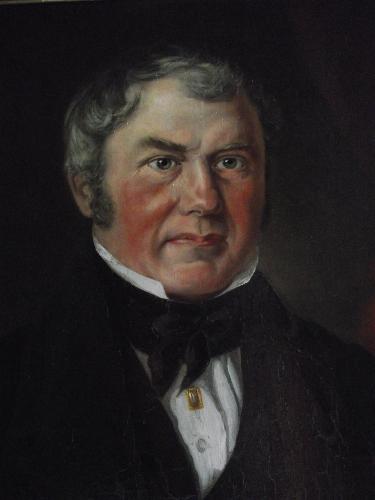| JOURNAL 2020 |
| North Craven Heritage Trust |
Two years ago we were contacted by a lady, from the Netherlands, enquiring whether we would be interested in buying a portrait of Richard Clapham (front cover) who had lived at Austwick Hall. She explained that she had lived in Kirkby Malham and had bought the oil painting from an antique dealer in Settle. Later she had returned to live in the Hague and taken the picture with her. It was not signed by the artist but inscribed on the back was ‘Richard Clapham of Feizor and Austwick’.
I already knew a little about Richard Clapham and wondered if I could find out who had painted his portrait. Richard was born in Feizor in 1791 and was the eighth generation of the family to have lived there. The earliest record was of another Richard, who was born there in 1598 [1]. Our subject married Isabella Hanson of Woodhouse, in Austwick, in March 1833, but she died shortly after the birth of the second child, Thomas Richard Clapham, in 1837. Richard inherited a small farm in Feizor but was also employed as a land surveyor by the Duchy of Lancaster as well as other clients. He was appointed the commissioner for the enclosure of Horton in Ribblesdale in 1847 and for Arncliffe the following year [2].
At his home in Feizor he created what was described as an apothecary’s garden and supplied John Tatham, of Settle, with a number of rare plants for his herbarium [3]. He was also known to have been a friend of Thomas Nuttall, the eminent naturalist [4].Clapham was listed as one of the subscribers to Henry Baines’ ‘Yorkshire Flora’ and was acknowledged by Miall and Carrington for providing records of flowering plants for their flora of the West Riding [5]. Some 33 species were listed, mostly found at Feizor, Austwick and Clapham. Most of them are still to be found in the area, though not always at the localities listed.
In 1846 Richard inherited Austwick Hall and its estate from Thomas Clapham of Stackhouse. It was an interesting act of generosity as the two men were not related, despite sharing the same surname. Richard died ten years later and his will and inventory provide some fascinating details [6]. Among his possessions was a library of about 250 books, valued at £90. Also listed were his pictures: ‘the testators portrait by Horner ... in the back parlour’ was valued at £14 and was left to his son, Thomas. Another portrait was described as ‘Old portrait on Landing’ was valued at £1 10s.
Thomas Clapham was a meticulous recorder and one of his journals has survived and is still in the possession of the Clapham family. It was a house journal and contains details the alterations to the Hall as well as a host of other things. In 1881 he referred to the death of his ‘old friend Joshua Horner’. Horner was born in Halifax and in the 1851 census he was described as an artist and portrait painter [7]. His father, John, was also listed as a drawing master. Calderdale Museums Service hold a small collection of portraits by Joshua so it was interesting to compare our portrait with the others. Unfortunately, our portrait was less well executed than those in the museum collection. With this doubt in mind further checks were made. All the museum’s portraits were on canvas whilst our’s was painted on a wooden board. On checking the journal again it was clear that the dimensions did not match. Thomas Clapham recorded that his father’s portrait by Horner measured 30 by 24 inches. Our picture is 18½ by 16 inches or 20½ by 22½ if the frame is included. It seems clear that our picture was not the work of Joshua Horner.
I thought that this was the end of the trail. Then I came across an entry for 1892, when Thomas’ older sister died at Beck House in Austwick. He went to collect some of her possessions which included ‘my father’s portrait by G. Brown’. So this is our artist. But who was he? I have found nothing about him, so he remains a mystery.
Finally, there is the question of the missing Horner portrait or rather portraits. Thomas Clapham also recorded portraits by Horner of himself and his sister. There were also 17 other works by Horner including two of the Hall. Where are they now?
References
- ’Clapham of Feizor’ in J F Turner Yorkshire Genealogist (Bingley: Harrison, 1888), p 189-90.
- National Archives MAF/1 94 & WRRDB6
- Whitwell, W ‘West Yorkshire records and notes from the herbarium catalogue etc of the late Mr John Tatham of Settle’, The Naturalist 1893: 25-40. Also see John Beckett’s ‘John Tatham of Settle, Quaker Botanist’ in the Journal 2017 p.20-22.
- Parker, E ‘Thomas Nuttall. Ribblesdale’s forgotten botanist, ornithologist and explorer’, Long Preston Heritage Group (2011).
- Baines, H ‘The flora of Yorkshire’ London: Longman (1840) and Miall, L C & Carrington, B ‘The flora of the West Riding’ London: Pamplin (1862).
- National Archives PROB 11/2252/329
- The dates for Horner are 1811-1881 based on baptismal records and Clapham’s journal, which do not match those provided by the Calderdale Museums Service of 1812-1884.
